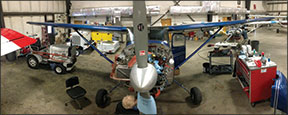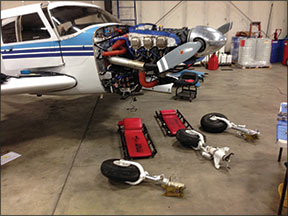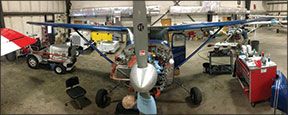As anyone who reads this magazine knows, most GA accidents are caused by the loose screw between the seat and rudder pedals. “Pilot induced” is the leading cause of accidents, not mechanical failure. But sometimes even mechanical failures can be attributable to aeronautical decision-making, like deciding to trust an aircraft after it has been in maintenance.

Let’s get something straight: Aircraft are not falling out of the sky with mechanical failures. Still, it’s just common sense to perform an extensive pre-flight inspection of any aircraft coming out of the maintenance shop. And on at least one level, you might think an aircraft would be more trustworthy after it has undergone an annual or 100-hour inspection, or had a major system repaired by a licensed mechanic. After all, that is the point of regular maintenance, right? But statistics don’t necessarily bear out this thinking. So, the pilots flying post-maintenance test flights need to up their game a bit.
If it’s not broken…
In a recent AOPA blog posting, aviation maintenance guru Mike Busch recalled WW-II-era studies conducted by British scientist Conrad Hal (C.H.) Waddington. Waddington studied the statistical relationship between maintenance intervals and reliability of British military aircraft. What he observed was that the number of unscheduled repairs was highest immediately after aircraft underwent scheduled maintenance, and steadily declined over time until the next scheduled maintenance. In other words, scheduled maintenance was the biggest cause of unscheduled maintenance. It essentially disturbed an otherwise perfectly good aircraft and caused a breakdown.
Busch’s takeaway message from Waddington’s study is: Maintenance isn’t an inherently good thing, at least in part because it can actually create issues rather than resolve them. Instead, maintenance should be reliability-based rather than schedule-based. And in turn, my takeaway from Busch’s analysis is: When a plane is returning to flight after maintenance, the PIC is actually the test pilot.
An examination of aviation accidents and incidents supports this observation. About a third of the accident reports covering mechanical issues contain something like the phrase “…the aircraft had recently undergone maintenance.” And often the statement goes on to specify the component system or part that subsequently failed, which resulted in or contributed to the accident.
The inclusion of that statement could be interpreted a couple ways. Either the system was having problems prior to the accident flight, which is why the plane had been in maintenance. Or the system was operable prior to maintenance, but was somehow rendered less functional thanks to the highly technical term “tinkering.” Of course, the inclusion of that statement doesn’t preclude the possibility that the mechanical issue was completely unpredictable, but the assumption is that the accident report contained that note for a reason.
Accident forensics can’t always clearly identify the root cause of an accident, but it’s reasonable to expect mechanical failures shortly after maintenance might be causally related to the act of maintenance. All too often, the components that fail are discovered to be mis-aligned, misassembled or missing, with lock nuts not used, cotter pins missing or a tool left in place. I found an example when I took off my pants recently.
Big Wheels
It’s not what you’re thinking; I’m referring to the wheel pants on my Cessna 180. When I made the decision, my goal was just get ready for the upcoming summer by putting on larger tires better suited to back-country flying. While this is in the category of work I am allowed to do as an owner, it also requires jacking the plane. And since I was busy with real work at the time, I relied on my mechanic, Josh, to get the job done.
When I returned to admire my slightly taller 180, Josh told me it was a good thing I decided to change tires. It turned out the nut holding a wheel on the axle was missing its retaining cotter pin. And not only was the bolt loose, it could be hand-loosened. I was a few arrivals away from one very ugly landing.
“Do you want to know what caused that?” Josh asked. I stood there thinking about all the ways a cotter pin could break or worry itself out of position. Knowing that Josh had 50 or so years experience as a mechanic, I expected to hear something drawn from his decades of practice. It was.
“Cell phone. I bet the last guy snugged it and got interrupted by a phone call.” He added, “That is why I don’t hire helpers. I either have to inspect everything they do or in many cases re-do it. It’s more trouble than it’s worth.”
A similar incident happened to a friend of mine when he picked up a Cessna R182 Skylane RG after it was painted by an extremely reputable shop. He had been anxious to get his plane back, calling more than once to find out when it would be ready, so he later realized he’d put schedule and delivery pressure on the shop. But on pickup day, his pre-flight inspection revealed nuts attaching a primary control surface had only been hand-tightened.

Embrace Your test-pilot Role
So what can you do? Trust but verify. Remember: After maintenance, you are a test pilot. In the case of the R182, the husband and wife who picked up the plane were both pilots as well as engineers. They had a checklist for the pre-flight that was informed by the knowledge their plane had been completely disassembled for painting. That pre-flight rigor may have saved their lives. I suppose you can land a plane with a stuck horizontal stabilizer, but it is better not to find out firsthand. Post maintenance pre-flights are critical.
On our best days, humans operate with a certain error rate, like surgeons who leave the occasional sponge or forceps inside the body cavity. No one is perfect—not surgeons, not pilots and not mechanics. You can demand perfection all day long, but you’re foolish if you think you are always going to get it. Fortunately, there’s a way we pilots can make up for known human error rates: constant diligence to verify flight critical systems before each flight…and then doubling down after maintenance.
Just as writers have editors, and mechanics have inspectors, every pilot who takes control of an aircraft recently released from maintenance should pay particular attention to all the systems that were touched.
Manufacturers Get It
This winter, I discovered the weak cylinder on my 180’s venerable O-470 had grown even weaker; it had a compression of 32 psi and was leaking through the valve. It seemed like good timing for some maintenance. Then I found out a jug on the other side was in the 40s, so they both came off. The inside of the cylinders were slightly pitted, and it turned out they fell outside of rebuild tolerance due to ring shelving, the wear at the top and bottom of the piston’s stroke where it reverses direction. I decided to do my part toward stimulating the economy and placed an order for six new cylinders. I also decided to install a new engine monitor to keep track of their temperatures and operating parameters.
The cylinders came with a break-in manual, which included an injunction that the first break-in flight should involve minimal crew. Hmm. What does it say about the risk of coming out of maintenance? And what does it say when the manufacturer of my new cylinders warns that the first flight is going to be a bit more dicey than a regular flight? Are they saying their parts might not work or might not be up to snuff? Are they lacking confidence?
Since the cylinders come with a warranty, I don’t think they are giving a no-confidence vote in their product. It’s more likely they are simply aware of the same thing Waddington and Busch observed: Mechanical work, ipso facto, makes mechanical failures more likely. In hindsight, I think I could have left the other four jugs on until they showed signs of weakness, but I didn’t.
Post-Maintenance Angst
I did not look forward to the first break-in flight. Weather made the wait interminable. At first it was too cold for break-in—it’s hard to get oil up to temp when the OAT is hovering at -15 degrees F. And then there was snow. A couple of days later, rain and more IMC. And there was my past experience, including two engine issues involving stuck valves, thrown rocker arms and bad valve guides. My rough engine experiences always ended safely on paved runways, but I may have a bit of PTSD when it comes to engine failures. I still vividly remember 15 minutes of my life outside Henderson, Nev., when Las Vegas Boulevard was my alternate runway until I had the airport made.
But the day finally came. Even though my cylinder manufacturer recommended minimal crew, I opted to take along a freshly minted A&P. I wanted someone who could monitor the cylinder break-in process as I attempted to keep the wings level and the plane separated from other aircraft.
The airplane was cowled and we pulled it out to the ramp for the first start and engine run. The break-in procedure calls for a three-minute run up at a moderate power setting, followed by a shut down and inspection. The first key indicator is oil pressure; you should have it. If you don’t, shut down and figure out why you don’t have it. Planes don’t fly without pilots and engines don’t run without oil. Maybe a rag fell into the crank case. Or maybe you forgot to seal the gasket on cylinder four, and it is spurting oil like a knight with a severed limb in a Monty Python movie spurts blood. The point is you are looking for signs of failure…so reassuring.
After run-up Number 1 came run-up Number 2. Again, we looked at the engine gauges. It’s just like you do on every flight, but on a test flight, it’s looking for failure, ready for the worst, not the happy confident scan on a clear day’s cruise flight. It’s a paranoid scan made with an expectation that something just might not be in the green.
After run-up Number 2, the mechanic cleared us for the flight with words of encouragement: “Watch your temps and stay close to the airport.” Again, not entirely reassuring, but then again no false promises. Every mechanic knows that post-maintenance flights are higher risk. They know that until the plane is running soundly, your flight’s success or failure is on them too. Pilots, mechanics and ATC have this one moment in common, if anyone of them makes a mistake, the pilot crashes. I’m starting to realize I like my mechanic more and more the less and less I see him.
Settling Down
After a bit of angst, and with the first, second and now third break-in flights behind me, I am starting to feel like a bit less like a test pilot. And as I get further and further away from the risk of an “infant mortality” mechanical failure, I’m returning to that comforting feeling where flights feel routine, to a place where I know my biggest risks are my own decision-making, competence and complacency.
Eventually I’ll get all the way back to where my biggest risk is the loose nut between the seat and the rudder pedals. They don’t make a cotter pin to keep that nut from coming loose. But I am okay with that.




